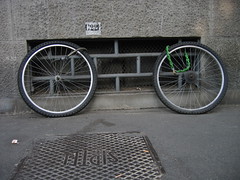An observation that took me all of 140 characters to pass on (using Twitter of course) was turned into a fairly substantial blog by another writer a few days ago. One of my Twitter followers noticed that blog, and immediately linked it to my earlier tweet. They asked me if I wasn’t annoyed that this guy had ‘stolen‘ my idea.
And you can quote me on that…
No. I was not annoyed.  Actually, it’s nice to inspire other people, I replied. And thinking further about this, I was only highlighting something that was tucked away in a long interview, but which, to me, seemed the most important fact from the interview – for a particular geographical audience. So my thought was not original in any way – I just focused on something already stated, which was very far from the headline – and just made it a headline item.
Actually, it’s nice to inspire other people, I replied. And thinking further about this, I was only highlighting something that was tucked away in a long interview, but which, to me, seemed the most important fact from the interview – for a particular geographical audience. So my thought was not original in any way – I just focused on something already stated, which was very far from the headline – and just made it a headline item.
Rather than feeling annoyed, I was happy that I’d helped to highlight something important that might otherwise have been ignored. Another writer, who followed my tweet nothings, chose to write about something I mentioned in more detail. Cool. I treat that as a compliment – he recognised that my insight was valuable – but I certainly did not expect any acknowledgment. Next time we talk, I’ll ask – and I would not be at all surprised to learn that he didn’t see my tweet in the first place.
Inspiration from other writers…
Just yesterday, writing my daily summary of a chapter from Age of Conversation 2, I browsed through to Ed Cottons Blog, as I’d chosen to write about his chapter – and came across a blog about the concept of originality, plagiarism, and theft, that cited a film-maker.
Rule #5: Nothing is original. Steal from anywhere that resonates with inspiration or fuels your imagination. Devour old films, new films, music, books, paintings, photographs, poems, dreams, random conversations, architecture, bridges, street signs, trees, clouds, bodies of water, light and shadows.
Select only things to steal from that speak directly to your soul. If you do this, your work (and theft) will be authentic. Authenticity is invaluable; originality is nonexistent. And don’t bother concealing your thievery—celebrate it if you feel like it.
In any case, always remember what Jean-Luc Godard said: “It’s not where you take things from—it’s where you take them to.”
— Jim Jarmusch
Quote from an interview with Moviemaker Magazine in 2004, brought to my attention by fellow AOC2 author Ed Cotton.
Now, I of course link to the original interview, and to Ed’s blog, simply because that’s the etiquette of blogging, and it keeps the lawyers happy when citing others’ work. But I also link because adding links and acknowledging sources makes my writing more authoritative, and makes it more interesting, as it may lead you, the reader, on to more interesting and surprising ideas and writing. Making those new connections might just inspire you.
Is this blog Art?
To me, it’s a centrally important aspect of blogs that they are inspired by other writers and new ideas, and the conversations and insight that arise when others join in a discussion inspired by a blog, a comment, or a tweet. (There can be a tendency towards an ‘echo-chamber’ at times, with many writers covering the same ground, but originals always stand out.)
 In the same way that writers like Tolstoy, Mayakovsky, Hemingway and Burns inspire me, and film-makers like Spielberg, Huston, Eisenstein and Boyle do, other bloggers also inspires me. And all of these artists borrow, rework, restate, refer to, parody, allude to, nod to, acknowledge, steal from and are fuelled by the work of others – whose work cannot fail to have been similarly created via other, inspired, precedents.
In the same way that writers like Tolstoy, Mayakovsky, Hemingway and Burns inspire me, and film-makers like Spielberg, Huston, Eisenstein and Boyle do, other bloggers also inspires me. And all of these artists borrow, rework, restate, refer to, parody, allude to, nod to, acknowledge, steal from and are fuelled by the work of others – whose work cannot fail to have been similarly created via other, inspired, precedents.
So is what you see before you a work of art? And where do you think I stole it from? Let’s hear from you…